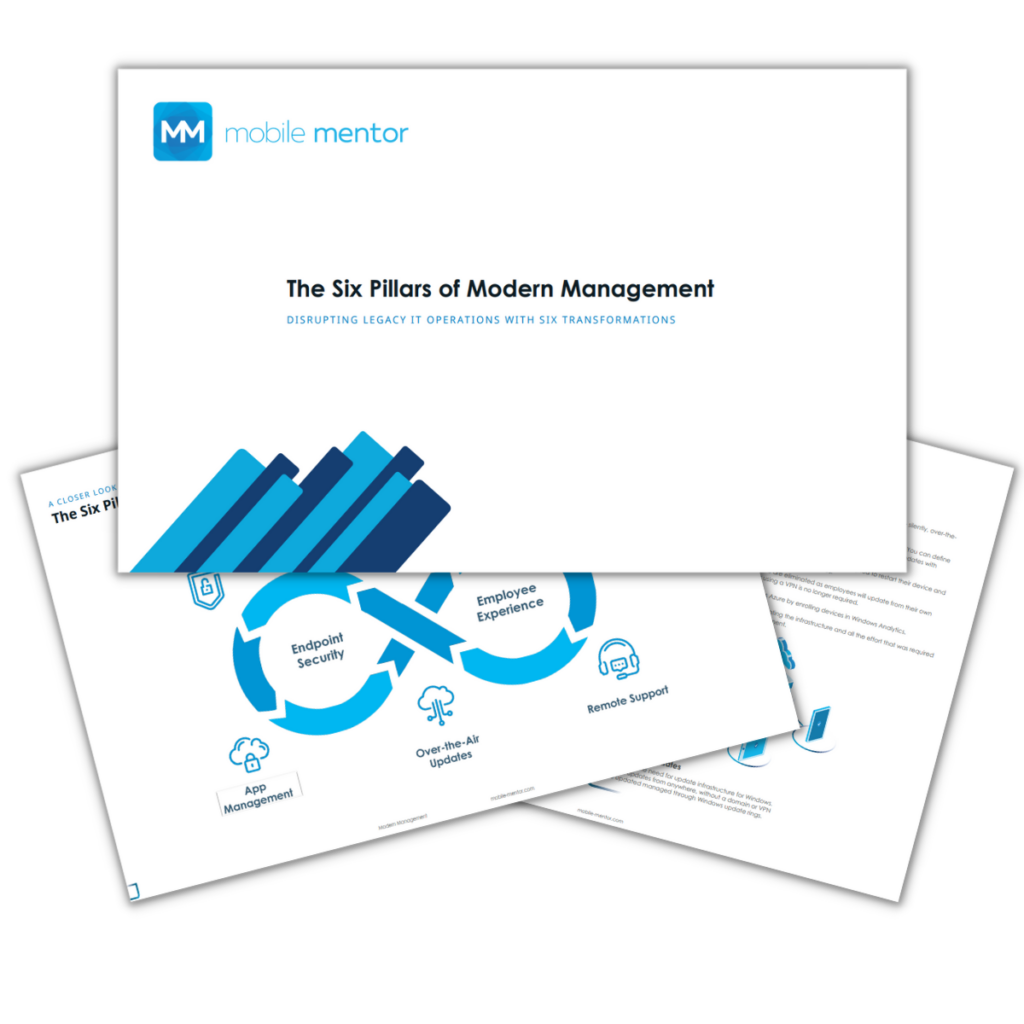
It would be an understatement to say that things have evolved in the MSP space over the past several years. And that’s a good thing. As our industry evolves, clients benefit from more efficient service, better security and a heightened end-user experience. But the reality is, that not all MSPs are created equal. From my perspective there are two schools – those who have embraced the power of modern endpoint management technologies and those who have not.
At Mobile Mentor, the clear endpoint management platform of choice is Intune. Microsoft is the clear leader for unified endpoint management on the Gartner Magic Quadrant. Simply put, Intune enables MSPs that have adopted it to deliver superior value compared to a traditional MSP that doesn’t leverage this powerful platform. Below we will dive into what advantages Intune brings to the table for Intune-powered MSPs and their clients.
Streamlining Onboarding and Offboarding
One significant pain point addressed by Intune is the onboarding and offboarding of end-users. Traditional MSPs often struggle with this process, leading to delays sometimes amounting to days or weeks, regular disruptions, and increased help desk tickets.
With Intune, the onboarding of new users is streamlined, taking an average of 15 to 20 minutes using Zero Touch Provisioning. This efficiency results in increased productivity, a positive perception from new employees of the business, and a reduction in help desk tickets by as much as 50%.
Seamless End User Experience
Intune enables MSPs to provide a consistent and seamless end-user experience, regardless of the user’s location. Whether working from the office or remotely, the deployment of laptops and desktops becomes a straightforward process, ensuring that end-users have access to the right applications and data with minimal disruptions.
Intune is designed to support remote work scenarios and ensure the same end-user experience regardless of an employee’s physical location. Traditional MSPs may face challenges in maintaining consistency across different locations. Managing endpoints manually can lead to variations in the user experience, especially for remote workers.
Efficient Troubleshooting and Ticket Reduction
The Intune platform allows for remote troubleshooting by quickly redeploying baseline profiles. This approach minimizes disruptions to end-users and significantly reduces the number of help desk tickets.
The efficient use of Intune’s technology stack contributes to a balanced approach between security and user experience – an equilibrium many traditional MSPs struggle to achieve.
Passwordless Authentication
Intune facilitates passwordless authentication through Windows Hello, enhancing security and eliminating the common issue of users forgetting passwords. This biometric authentication method not only improves security but also provides a smoother and more secure login experience for end-users.
Traditional MSPs, without the specialized features of Intune, may rely on conventional password-based authentication, exposing users to the challenges of password management and potential security vulnerabilities. Intune’s implementation of passwordless authentication reflects a forward-looking approach to security and user convenience that sets it apart from traditional MSP practices.
Consistent Security Measures and Compliance
Intune delivers centralized security measures across all endpoints, ensuring a consistent and robust security posture. This includes features like conditional access policies, device compliance checks, and threat protection. Traditional MSPs often struggle to implement such consistent security measures, increasing the risk of security breaches and compliance violations.
In contrast, traditional MSPs often face challenges in implementing such uniform security measures due to the absence of a specialized platform like Intune. The result is a potential increase in the risk of security vulnerabilities and non-compliance for traditional MSPs and their clients.
Centralized Endpoint Profile Management
Unlike traditional MSPs that manage endpoints in a one-to-one relationship, Intune allows for the centralized management of endpoint profiles. This streamlines the distribution of profiles and simplifies issue resolution, reducing the complexity and time required for management.
Cost Savings and Licensing Inclusions
By leveraging Intune and the Microsoft 365 technology stack, Intune-powered MSPs can pass on cost savings to customers. The integration with Microsoft 365 enhances collaboration and provides access to a broader range of features. Additionally, Intune is included in Windows 365 licensing, making it accessible to a wide range of Microsoft customers.
Conclusion
In conclusion, choosing an Intune-powered MSP offers numerous advantages, from efficient onboarding and troubleshooting to enhanced security measures and cost savings. The platform’s ability to adapt to the needs of both small businesses and large enterprises makes it a valuable asset for modern managed service providers.
Download the Six Pillars of Modern Endpoint Management
Deep Dive Concepts such as:
- Zero Trust
- Passwordless Authentication
- Zero Touch Provisioning
- App Management
- Over-The-Air Updates
- Remote Support


Craig Guice
Craig boasts over 18 years of experience at the helm of his own company, where he cultivated a rare blend of technical prowess and business acumen. Craig’s expertise lies in navigating complex IT landscapes, from companies with no IT staff to those with fully-fledged departments. Today, he leverages his extensive background to assist businesses in selecting and integrating Cloud Computing, Managed Services, and Cyber Security solutions, resolving their most challenging IT dilemmas with precision and efficiency.



